As a fitness and wellness mentor and online coach, I greatly advocate for full-body strength training. It is not only amazing for the improvement of your metabolism, fat loss, and muscle, bone, and joint health but also beneficial for your overall health. When you want to develop and strengthen your shoulder muscles, you should train all areas of the deltoids. An exercise that’s amazing for the shoulders is lateral side raises.
Below we’ll look deeper into lateral raises and we’ll cover the following:
- Muscles involved in lateral raises
- Benefits associated with lateral raises
- How to properly do lateral raises
- Common mistakes when performing lateral raises
- Video on how to do lateral raises
- Shoulder exercises to complete your shoulder workout
The shoulder has several muscles that attach to the scapula, humerus, and clavicle. The most significant shoulder muscle is the deltoid, which consists of the anterior, middle, and posterior fibers, giving the shoulder that nice rounded look. There are other muscles – the supraspinatus, infraspinatus, teres minor, and subscapularis – that form the rotator cuff and are vital in the dynamics of shoulder movement.
Other muscles involved in shoulder movement are the deltoid, supraspinatus, coracobrachialis, serratus anterior, pectoralis, trapezius, latissimus dorsi, teres major, and rhomboid major among others. The shoulder area is one of the most mobile spheres in the body. The wide range of motion permits great rotation, abduction, and adduction. Simultaneously, this versatility makes the shoulder area more prone to injury.
Muscles Worked in Lateral Raises

Let’s delve into the primary muscles targeted in lateral raises:
- Lateral deltoid – the main muscle targeted is the side of the shoulder. This muscle is involved in shoulder abduction, drawing away the arm from the body
Secondary Muscles:
- Anterior deltoid – the front of the shoulder. It’s involved in shoulder flexion, flexing, and medially rotating the arm
- Rear deltoid – the back of the shoulder. It is a powerful extensor, extending and laterally rotating the arm
- Trapezius (traps) – triangular muscles extending over the back of the neck and shoulders. The superior part of the trapezius elevates the scapula; the middle part retracts the scapula; the inferior part depresses the scapula. The superior along with the inferior fibers help rotate the scapula
- Wrist extensors – the brachioradialis, extensor carpi ulnaris, and extensor carpi radialis longus, and brevis. These muscles extend the wrist, helping you grip
- Serratus anterior – muscle originating on the surface of the 1st to 8th ribs at the side of the chest and ending at the medial border of the scapula. It pulls the scapula forward
Benefits of Lateral Raises
Now that you know what muscles are directly involved in the movement, it’s time to identify the benefits associated with lateral raises:
- Aesthetics: Lateral raises give your body a great look by giving your shoulders a rounder look.
- Mobility: They help increase your shoulders’ range of motion.
- Efficient: They don’t require a lot of weight and give you great results. You can feel them working even with light weights.
- Strength: Strong shoulders help you with daily activities when you need to pick up items or even the kids.
- Versatility: You can perform different variations of the lateral raise. You can raise both arms at the same time, one arm at a time, or alternate arms.
- Posture: Lateral side raises engage your core, upper back, and neck muscles which help you to maintain a more upright posture.
- Simplicity: There is not much involved in the movement – all you need is a pair of dumbbells.
How to Do Dumbbell Lateral Raises

- Plant your feet solidly on the ground and grab a pair of dumbbells in each hand with arms resting by your sides of the body
- Stand with your back straight, core tight, and shoulders back
- Lift the weights out to the side until your arms are parallel to the floor or a little bit higher, with the elbow slightly bent.
- Hold the weight at the peak for a second or two
- Slowly bring the weight down to the starting position
- Pause at the bottom for another second
- Repeat 8-12 times
Mistakes to Avoid
- Avoid Rushing: Avoid moving the weights up too fast since this keeps the muscles under tension for a shorter period. You should control the weights and perform the exercise in a controlled fashion. This exercise is not about speed. You feel it more when you are doing it slowly.
- Avoid Shrugging: When you shrug or raise your shoulder blades during the rep, you use your traps to lift the weights up instead of your deltoids.
- Rounding Your Back: Avoid rounding your lower back. This excessive arching can hurt your back and may indicate that the weights are too heavy. Keep your back straight and use a weight that allows for proper movement mechanics.
Dumbbell Side Lateral Raises Video
Shoulder Workout
You can complete your shoulder workout by performing the following exercises:
As you can see the lateral raise is a wonderful shoulder exercise. It offers tremendous benefits associated with hypertrophy, strength, endurance, and aesthetics. Now that you know how to properly perform lateral raises, you can avoid the most common mistakes and enjoy their benefits. Remember, whether you want to lose weight, tone your body, or gain strength or size, all muscles must be trained.
Lift, Burn more Fat, Get Stronger, and Live Healthier!
To a Fitter Healthier You,
The Fitness Wellness Mentor



